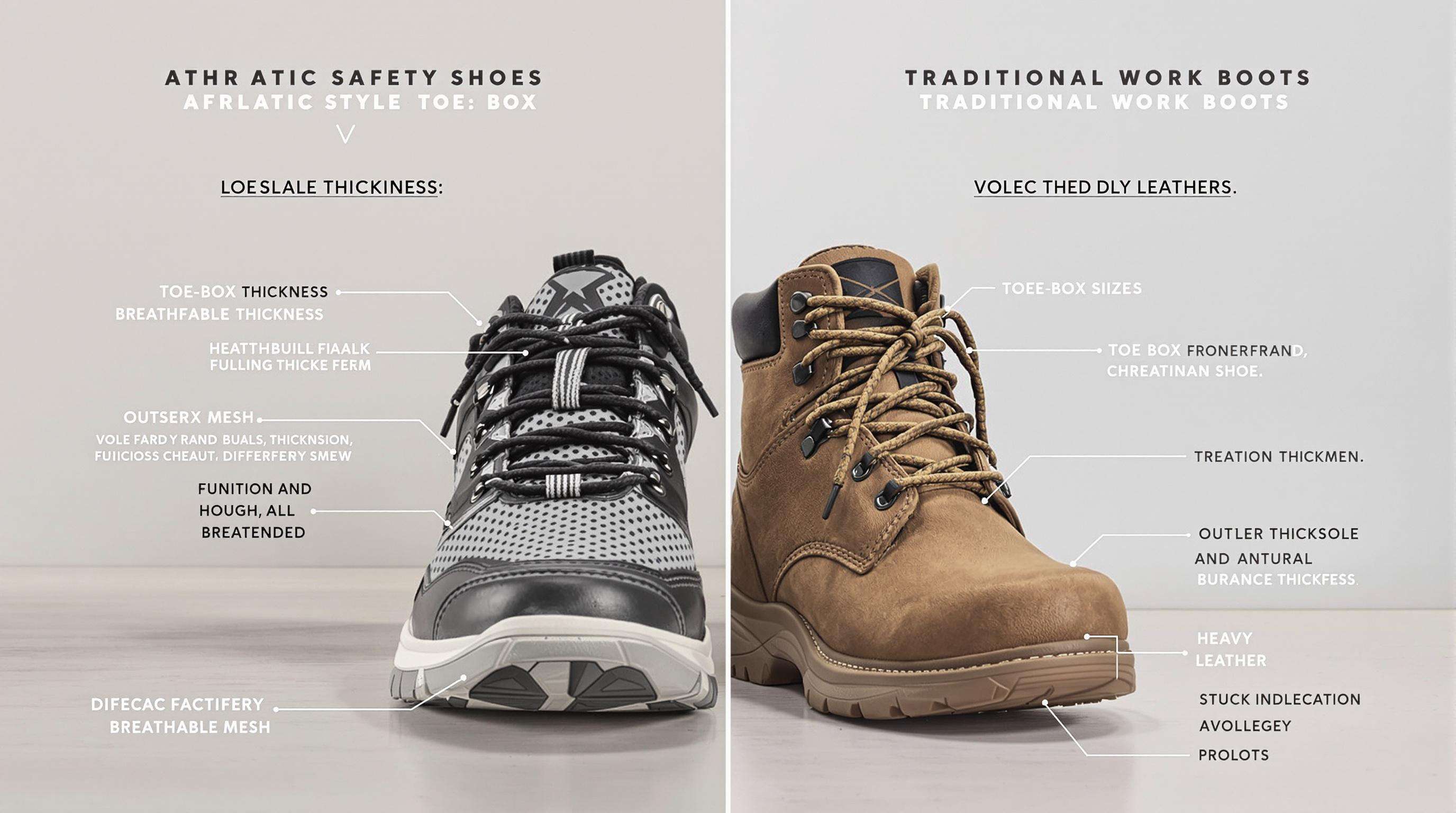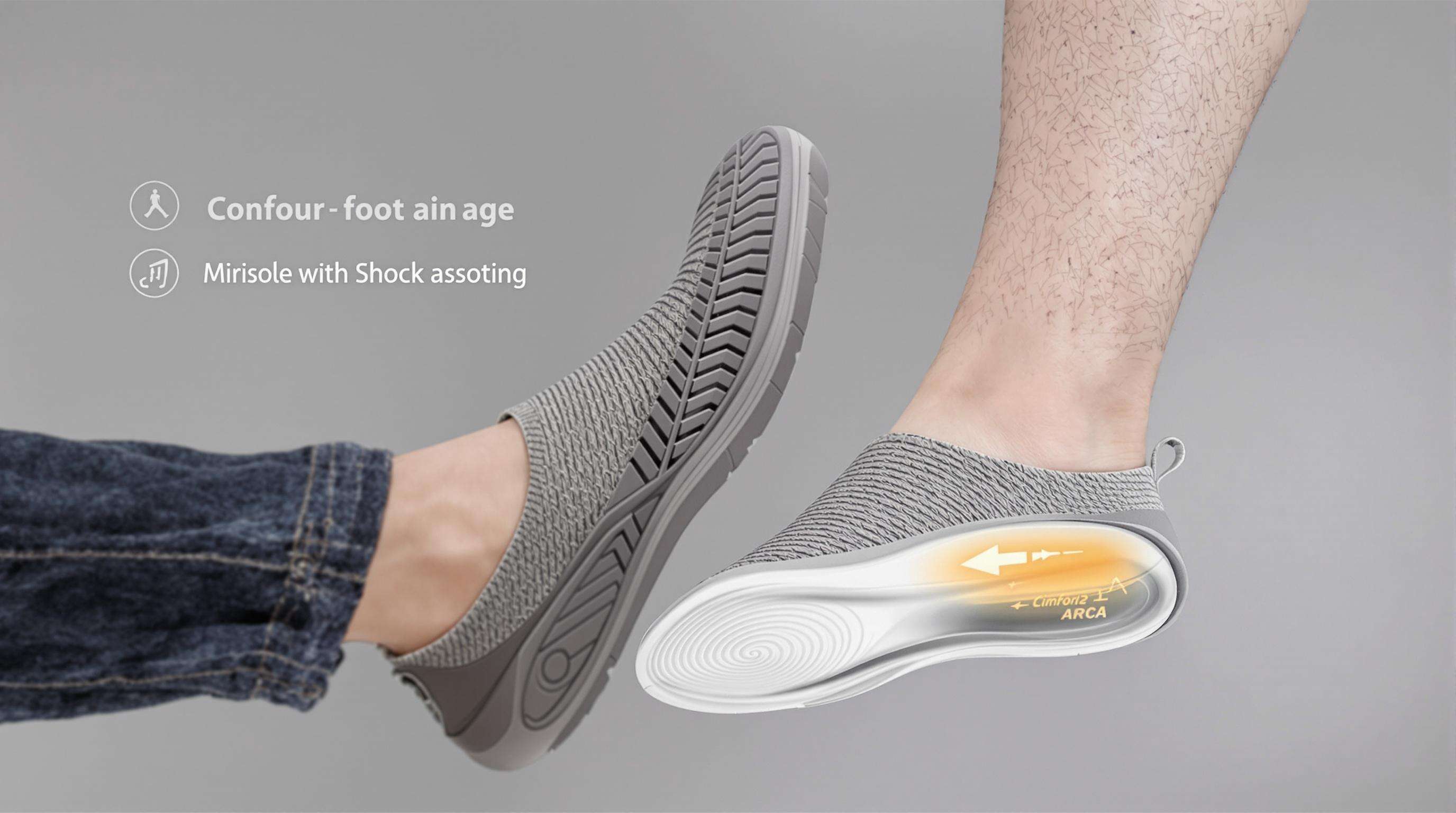Hoy en día, los lugares de trabajo están apostando realmente por calzado de protección ágil. Según algunos informes del sector de 2024, los sectores logísticos y de fabricación han experimentado un aumento bastante significativo en calzado de seguridad con estilo deportivo en los últimos años. Las personas que trabajan en esas naves industriales concurridas y cerca de líneas de producción automatizadas necesitan zapatos que cumplan con todos los requisitos de OSHA, pero que también se sientan tan ágiles como los zapatillas deportivas normales. Tiene sentido si lo piensas. Un reciente análisis del mercado global de calzado de seguridad también reveló algo interesante: muchos trabajadores más jóvenes de menos de 35 años realmente valoran más la libertad de movimiento por encima de cualquier otra cosa a la hora de elegir sus calzados de trabajo. Estas zapatillas de seguridad con diseño deportivo parecen estar ganando terreno entre ellos.
Las viejas botas de puntera de acero de 2.5 libras están siendo reemplazadas por versiones más ligeras con puntera compuesta que pesan menos de 1.8 libras, pero que aún cumplen con los estándares de seguridad ASTM F2413-18. Los nuevos materiales han cambiado completamente el juego en la actualidad. Estamos viendo materiales como polímeros de calidad aeroespacial combinados con telas transpirables de punto que reducen significativamente la fatiga en los pies después de largas jornadas laborales. Algunos estudios muestran que los trabajadores reportan alrededor de un 40% menos de fatiga al usar estos nuevos diseños durante 10 horas seguidas. ¿Qué hace esto posible? Bueno, los fabricantes han descubierto cómo hacer capas protectoras mucho más delgadas sin sacrificar la resistencia o los niveles de protección contra compresión, lo cual es bastante impresionante considerando los requisitos anteriores.
La Generación Z representa aproximadamente el 32% de los trabajadores en plantas manufactureras según la última encuesta de la plantilla de PwC del 2023, y estos empleados más jóvenes están definitivamente cambiando lo que las personas esperan de su equipo de seguridad. Los supervisores de fábrica también han notado algo interesante: muchas instalaciones ven un cumplimiento aproximadamente 70% mejor cuando ofrecen botas de trabajo que realmente se sienten como calzado deportivo, con forros internos transpirables y un adecuado soporte del arco que no dejan los pies adoloridos después de las jornadas laborales. El mercado está respondiendo rápidamente a esta tendencia. Los principales fabricantes están destinando la mayor parte de su presupuesto de investigación a crear equipos que se adapten mejor y resulten más cómodos, en lugar de simplemente intentar hacer que los diseños existentes duren más mediante pequeñas modificaciones.

Los zapatos de seguridad deportivos presentan una forma anatómica con entresuelas estilizadas cuyo grosor medio es de 18–22 mm, en comparación con las plataformas rígidas tradicionales de 25–30 mm. Sus punteras reforzadas ocupan un 15–20% menos de espacio vertical, cumpliendo aún con los estándares de impacto ASTM F2413-18, lo que permite una posición natural del pie durante movimientos dinámicos.
Las punteras compuestas reducen el peso del calzado en un 30–40% en comparación con las de acero, con diseños en estilo atlético que pesan en promedio entre 1,8–2,2 lbs frente a las 3,1–3,5 lbs de las botas tradicionales. Estudios ergonómicos muestran que el 72% de los trabajadores reporta una reducción de la fatiga al cambiar a zapatos deportivos de seguridad ligeros para tareas que involucran arrodillarse frecuentemente o subir escaleras.
Los calzados de seguridad inspirados en lo atlético logran un 40 % más de flexibilidad en la puntera gracias a su suela exterior segmentada y zonas de flexión diseñadas, según verificó la prueba de resistencia a la flexión ASTM D7254. Este diseño permite una dorsiflexión promedio del tobillo de 28° frente a los 18° de las botas tradicionales, lo cual es fundamental para trabajos en cuclillas prolongados o sobre techos.
Los últimos modelos de calzado de seguridad ahora incorporan paneles de malla transpirable que permiten un flujo de aire aproximadamente un 50% mejor que el de las partes superiores tradicionales de cuero, cuando se prueban en condiciones controladas de humedad. Los fabricantes también han desarrollado diseños de tejido triple capa que ofrecen el mismo nivel de protección contra cortes que el cuero vacuno según la norma ANSI/ISEA 121-2018, pero estos nuevos materiales pesan alrededor de un 45% menos. Además, los trabajadores también notan la diferencia. Informes industriales de seguridad muestran un preocupante aumento del 63% en las quejas por pies sudorosos desde 2020, lo que convierte estos avances en comodidad en un alivio bienvenido para quienes pasan largas horas de pie en entornos exigentes.
Las botas de seguridad para el lugar de trabajo deben seguir regulaciones específicas establecidas por OSHA bajo el código 29 CFR 1910.136, así como las normas ASTM F2413-18. Estas normativas exigen protección contra impactos de hasta 75 libras-pie, resistencia a la compresión de al menos 2,500 libras y protección contra peligros eléctricos. El sistema de etiquetado ayuda a los trabajadores a identificar el equipo conforme: busque clasificaciones I/75 C/75 EH, que indican cumplimiento total en todas esas categorías. Muchos fabricantes ahora producen calzado de seguridad con estilo deportivo que también cumple con estos requisitos exigentes, pero ofrece una mejor movilidad y comodidad en comparación con los diseños rígidos tradicionales. Este cambio refleja las necesidades cambiantes en los lugares de trabajo, donde los empleados desean equipos de protección que no sacrifiquen movilidad por seguridad.
Según las normas ASTM, el calzado de seguridad debe soportar impactos de hasta 75 libras-pie y fuerzas de compresión tan altas como 2.500 libras. Las botas con puntera de acero tradicionalmente han superado ampliamente estos valores, pero actualmente los zapatos de seguridad se fabrican cada vez más con materiales compuestos. Estas nuevas opciones también superan las pruebas requeridas, a la vez que resultan mucho más ligeras para los pies. Analizando las tendencias recientes del mercado, alrededor del 42 por ciento de los nuevos modelos de calzado de seguridad lanzados incorporan construcción compuesta. Eso representa un cambio real en lo que los trabajadores buscan hoy en día en su equipo de protección. Gracias a los avances en ciencia de materiales de los últimos años, el menor peso no significa una protección comprometida.
Según la norma ASTM F2413-18, las puntas de acero y las compuestas deben soportar exactamente el mismo nivel de fuerza de impacto. Aunque el acero sigue siendo lo más adecuado para trabajos realmente exigentes en obras de construcción, las opciones compuestas que vemos en muchas botas de seguridad actuales ofrecen una protección similar pesando aproximadamente un 30 a 40 por ciento menos. Algunas pruebas indican que los materiales compuestos manejan la energía de impacto incluso mejor que el aluminio en un 15 por ciento, lo que los hace menos fatigosos para los trabajadores que se mueven durante todo el día en entornos laborales activos.
| Material | Peso (onzas) | Clasificación de Impacto | Casos de uso típicos |
|---|---|---|---|
| Acero | 14-18 | ASTM I/75 | Fabricación pesada, construcción |
| Compuesto | 8-12 | ASTM I/75 | Logística, trabajo eléctrico |
| Aluminio | 10-14 | ASTM I/50 | Industria ligera, HVAC |
El acero sigue siendo el estándar para riesgos extremos, mientras que las compuestas dominan el calzado de seguridad deportivo debido a sus ventajas ergonómicas. Las puntas de aluminio ofrecen una solución intermedia para aplicaciones de riesgo moderado.
Los calzados de seguridad incorporan patrones de tacos multidireccionales y compuestos de caucho resistentes al aceite que mantienen un 40% más de contacto con la superficie que las suelas convencionales con tacos en condiciones mojadas. Estos diseños cumplen con la norma ASTM F2913 de resistencia al deslizamiento mediante pruebas rigurosas en superficies inclinadas contaminadas con agua y aceite hidráulico.
El calzado para construcción requiere entresuelas resistentes a una penetración de 2.200 PSI proveniente de clavos o barras de refuerzo, mientras que los modelos para industrias de servicios utilizan placas compuestas más delgadas clasificadas para 1.100 PSI. Esto refleja niveles de riesgo diferentes: los trabajadores de la construcción enfrentan 12 veces más lesiones por perforación en los pies anualmente que el personal de retail (BLS 2023).
Las botas tradicionales de cuero logran la certificación EH mediante suelas conductoras que conectan a tierra de forma segura circuitos de 18 kV. Investigaciones recientes sobre materiales muestran que los zapatos de seguridad deportivos utilizan compuestos no metálicos que disipan cargas estáticas y bloquean corrientes de hasta 600 V, lo que los hace adecuados para entornos de baja tensión.
El calzado de seguridad marino incluye canales de drenaje y malla hidrofóbica en el empeine que elimina 500 mL de agua en 8 segundos durante las pruebas. En contraste, los modelos para almacenes priorizan la estabilidad lateral con suelas exteriores ensanchadas que incrementan el área de contacto en un 35 % en plataformas con estanterías comparado con botas tradicionales de puntera redonda.

Los calzados de seguridad modernos integran plantillas anatómicas y suelas intermedias con absorción de impactos para combatir la fatiga en las extremidades inferiores, la cual ha aumentado un 42% entre los trabajadores de almacenes que usan botas tradicionales (Encuesta de Calzado para la Fuerza Laboral 2024). Los sistemas de acolchado de poliuretano reducen la presión máxima un 28% durante turnos de 10 horas, manteniendo al mismo tiempo la protección para puntera según la norma ASTM F2413-18.
Las partes superiores perforadas y los forros antimicrobianos en calzado de seguridad con diseño deportivo reducen la retención de humedad, contribuyendo a una disminución del 65% en lesiones relacionadas con ampollas en empleos manufactureros desde 2022. Las membranas de evacuación de la humedad en calzado de seguridad deportivo mantienen una transpirabilidad un 34% mejor que la de las botas tradicionales de cuero durante turnos prolongados.
Los centros de distribución reportan una adopción 40% mayor de calzado deportivo de seguridad, impulsada por su peso 19% más ligero y puntos de flexión rotacionales que mejoran la eficiencia del paso en entornos de alta movilidad. Los diseños con puntera compuesta igualan la resistencia al impacto de 75J de las puntas de acero, reduciendo el peso en la parte delantera del pie en 8,2 onzas.
A pesar de los avances en calzado deportivo, el 78% de las empresas constructoras aún exigen protección contra riesgos eléctricos Clase E y resistencia a la perforación de 200N/mm² que se encuentran en las botas tradicionales (Revisión de Seguridad en la Construcción 2023). Las partes superiores de cuero completo y soportes rígidos para el tobillo siguen siendo esenciales para el 92% de los trabajadores que manejan materiales pesados en terrenos irregulares.
Los trabajadores menores de 35 años priorizan la libertad de movimiento y la comodidad, razón por la cual se inclinan hacia zapatos de seguridad de estilo deportivo que ofrezcan estas características manteniendo al mismo tiempo los estándares de seguridad.
Las punteras compuestas son un 30-40 % más ligeras que las punteras de acero y ofrecen una protección similar, siendo más cómodas para actividades que requieren flexibilidad y movimiento, como arrodillarse y subir escaleras.
Materiales contemporáneos como polímeros aeroespaciales y tejidos transpirables de punto contribuyen a diseños más ligeros, reducen la fatiga en los pies, mejoran la transpirabilidad y suelen ofrecer una protección equivalente o superior a la de los materiales tradicionales.
Sí, muchos zapatos de seguridad con estilo deportivo cumplen con los estrictos requisitos de OSHA y ASTM F2413-18, ofreciendo la protección necesaria mientras mejoran el confort y la movilidad en el trabajo.
Las botas tradicionales ofrecen características esenciales como protección contra riesgos eléctricos de Clase E y alta resistencia a la perforación, las cuales son fundamentales para manipular materiales pesados y desplazarse por terrenos irregulares en obras de construcción.
Derechos de autor © 2024© Shandong Max Gloves Sales Co., Ltd.--Política de privacidad